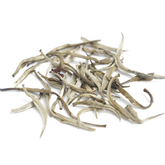Introduction to Chinese Ripe Pu-erh Tea and Its Health Benefits
Introduction to Pu-erh Tea
Pu-erh tea is a type of fermented tea originating from Yunnan Province in China, renowned for its unique flavor and health benefits. Pu-erh tea is primarily categorized into two main types: raw Pu-erh tea (unfermented) and ripe Pu-erh tea (artificially fermented). Raw Pu-erh tea typically offers a fresher taste with higher aroma, while ripe Pu-erh tea undergoes a fermentation process, resulting in a rich and mellow flavor. Over time, the taste of ripe Pu-erh tea becomes more complex and smooth. Both raw and ripe Pu-erh teas are considered ideal for aging and collecting, making them a popular choice among tea enthusiasts not only for their flavor but also for their health benefits.

Major Production Areas of Pu-erh Tea
Pu-erh tea is predominantly produced in China's Yunnan Province, especially in the southwestern regions of Yunnan. The key production areas include Menghai County, Mengla County, Pu'er City, and Lincang City. The distinct growing conditions, elevation, and climate variations in these regions give rise to unique flavor profiles for the Pu-erh teas produced. These diverse production areas contribute to the richness and variety of Pu-erh tea flavors, making it a favorite among tea connoisseurs. The unique geographical environment of Yunnan imparts Pu-erh tea with its characteristic earthy and robust taste, highly appreciated by tea lovers.(How to make tea better?)
Brewing Guide For Ripe Puerh Tea
The best utensils for brewing ripe Pu-erh tea are typically a Yixing clay teapot or a gaiwan. For a more straightforward approach, you can use a thermos cup. For a 120ml Yixing teapot, use about 6 grams of tea leaves. Start by rinsing the tea twice with boiling water at 95-100°C to remove any impurities and awaken the tea's aroma. After rinsing, pour hot water into the gaiwan or teapot, steeping the tea for 20-30 seconds, adjusting the time according to personal taste. After each steep, promptly pour out the tea to avoid over-steeping the leaves. As the number of infusions increases, you can gradually extend the steeping time. The unique mellow flavor of ripe Pu-erh tea will gradually unfold, providing a sense of warmth and relaxation, making it an ideal choice for daily enjoyment and relaxation.(more about brewing tea gu

Health Benefits of Ripe Pu-erh Tea
In southern China, ripe Pu-erh tea cake is particularly popular among the elderly due to its gentle effect on the digestive system. Pu-erh tea is an integral part of daily life in Chinese households, often consumed after meals to aid digestion and reduce greasiness. Modern scientific research has confirmed and demonstrated various health benefits of Pu-erh tea, especially ripe Pu-erh tea, which are often listed in tea benefits charts.
-
Aids Digestion and Improves Digestive Function
- Effect: Helps alleviate indigestion and enhance digestive function.
- Reason: Certain components in Chinese oolong tea and Pu-erh tea (such as catechins and polyphenols) promote the secretion of digestive enzymes.
- Evidence: Studies have shown that Chinese oolong tea and Pu-erh tea can effectively improve digestive function and reduce the feeling of greasiness. (Source: Journal of Nutrition)
-
Boosts the Immune System
- Effect: Enhances the body's natural immunity.
- Reason: Chinese green tea and Pu-erh tea are rich in antioxidants (such as vitamin C and catechins), which help fight free radicals and boost the immune system.
- Evidence: Catechins in green tea have been proven to enhance immune function. (Source: Frontiers in Immunology)
-
Promotes Cardiovascular Health
- Effect: Lowers cholesterol, improves blood circulation, and reduces the risk of cardiovascular diseases.
- Reason: Polyphenols found in Chinese black tea and green tea help improve blood lipid levels and vascular health.
- Evidence: Multiple studies have indicated that green and black teas can help lower cholesterol levels and blood pressure. (Source: American Journal of Clinical Nutrition)
-
Enhances Metabolism
- Effect: Accelerates fat metabolism and aids in weight management.
- Reason: Caffeine and catechins in Chinese green tea and Pu-erh tea can stimulate metabolism and fat burning.
- Evidence: Research has found that Chinese green tea can increase basal metabolic rate, helping to burn more fat. (Source: Obesity Research)
-
Improves Skin Health
- Effect: Maintains healthy skin and reduces signs of aging.
- Reason: Antioxidants in Chinese green tea and Pu-erh tea (such as catechins and vitamin C) help protect the skin from environmental damage.
- Evidence: Antioxidant components in green tea can improve skin elasticity and reduce wrinkles. (Source: Journal of Dermatological Science)
Conclusion
These health benefits of ripe Pu-erh tea are supported by scientific research. Drinking chinese tea in moderation daily can be part of a healthy lifestyle, but it should not replace medical treatment. In southern China, even children as young as six drink tea with their parents every day, underscoring the importance of tea in a healthy and daily lifestyle. Whether you're interested in the weight loss benefits of Pu-erh tea, its digestive health benefits, or simply enjoy the ritual of brewing a perfect cup of tea, Pu-erh tea can meet your needs
Incorporating ripe Pu-erh tea into daily life is not only a delightful experience but also a healthy choice. Whether you use a gaiwan or a glass teapot to brew your favorite loose leaf tea, explore the rich traditions and health benefits of this iconic Chinese tea and enjoy its unique role in promoting health and enhancing your tea-drinking experience.
SEE MORE
If you have questions about selecting tea:
Learn-more-about-chinese-tea
If you have questions about the benefits of tea:
Health-benefits-of-chinese-tea
If you have questions about brewing tea:
How-to-brew-loose-leaf-tea






